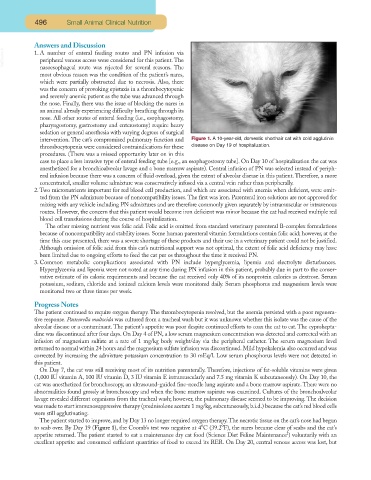Page 482 - Small Animal Clinical Nutrition 5th Edition
P. 482
496 Small Animal Clinical Nutrition
Answers and Discussion
VetBooks.ir 1. A number of enteral feeding routes and PN infusion via
peripheral venous access were considered for this patient. The
nasoesophageal route was rejected for several reasons. The
most obvious reason was the condition of the patient’s nares,
which were partially obstructed due to necrosis. Also, there
was the concern of provoking epistaxis in a thrombocytopenic
and severely anemic patient as the tube was advanced through
the nose. Finally, there was the issue of blocking the nares in
an animal already experiencing difficulty breathing through its
nose. All other routes of enteral feeding (i.e., esophagostomy,
pharyngostomy, gastrostomy and enterostomy) require heavy
sedation or general anesthesia with varying degrees of surgical
intervention. The cat’s compromised pulmonary function and Figure 1. A 10-year-old, domestic shorthair cat with cold agglutinin
thrombocytopenia were considered contraindications for these disease on Day 19 of hospitalization.
procedures. (There was a missed opportunity later on in this
case to place a less invasive type of enteral feeding tube [e.g., an esophagostomy tube]. On Day 10 of hospitalization the cat was
anesthetized for a bronchioalveolar lavage and a bone marrow aspirate). Central infusion of PN was selected instead of periph-
eral infusion because there was a concern of fluid overload, given the extent of alveolar disease in this patient. Therefore, a more
concentrated, smaller volume admixture was conservatively infused via a central vein rather than peripherally.
2. Two micronutrients important for red blood cell production, and which are associated with anemia when deficient, were omit-
ted from the PN admixture because of noncompatibility issues. The first was iron. Parenteral iron solutions are not approved for
mixing with any vehicle including PN admixtures and are therefore commonly given separately by intramuscular or intravenous
routes. However, the concern that this patient would become iron deficient was minor because the cat had received multiple red
blood cell transfusions during the course of hospitalization.
The other missing nutrient was folic acid. Folic acid is omitted from standard veterinary parenteral B-complex formulations
because of noncompatibility and stability issues. Some human parenteral vitamin formulations contain folic acid; however, at the
time this case presented, there was a severe shortage of these products and their use in a veterinary patient could not be justified.
Although omission of folic acid from this cat’s nutritional support was not optimal, the extent of folic acid deficiency may have
been limited due to ongoing efforts to feed the cat per os throughout the time it received PN.
3. Common metabolic complications associated with PN include hyperglycemia, lipemia and electrolyte disturbances.
Hyperglycemia and lipemia were not noted at any time during PN infusion in this patient, probably due in part to the conser-
vative estimate of its caloric requirements and because the cat received only 40% of its nonprotein calories as dextrose. Serum
potassium, sodium, chloride and ionized calcium levels were monitored daily. Serum phosphorus and magnesium levels were
monitored two or three times per week.
Progress Notes
The patient continued to require oxygen therapy. The thrombocytopenia resolved, but the anemia persisted with a poor regenera-
tive response. Pasteurella multocida was cultured from a tracheal wash but it was unknown whether this isolate was the cause of the
alveolar disease or a contaminant. The patient’s appetite was poor despite continued efforts to coax the cat to eat. The cyprohepta-
dine was discontinued after four days. On Day 4 of PN, a low serum magnesium concentration was detected and corrected with an
infusion of magnesium sulfate at a rate of 1 mg/kg body weight/day via the peripheral catheter. The serum magnesium level
returned to normal within 24 hours and the magnesium sulfate infusion was discontinued. Mild hypokalemia also occurred and was
corrected by increasing the admixture potassium concentration to 30 mEq/l. Low serum phosphorus levels were not detected in
this patient.
On Day 7, the cat was still receiving most of its nutrition parenterally. Therefore, injections of fat-soluble vitamins were given
(1,000 IU vitamin A, 100 IU vitamin D, 3 IU vitamin E intramuscularly and 7.5 mg vitamin K subcutaneously). On Day 10, the
cat was anesthetized for bronchoscopy, an ultrasound-guided fine-needle lung aspirate and a bone marrow aspirate. There were no
abnormalities found grossly at bronchoscopy and when the bone marrow aspirate was examined. Cultures of the bronchoalveolar
lavage revealed different organisms from the tracheal wash; however, the pulmonary disease seemed to be improving. The decision
was made to start immunosuppressive therapy (prednisolone acetate 1 mg/kg, subcutaneously, b.i.d.) because the cat’s red blood cells
were still agglutinating.
The patient started to improve, and by Day 13 no longer required oxygen therapy.The necrotic tissue on the cat’s nose had begun
º
º
to scab over. By Day 19 (Figure 1), the Coomb’s test was negative at 4 C (39.2 F), the nares became clear of scabs and the cat’s
f
appetite returned. The patient started to eat a maintenance dry cat food (Science Diet Feline Maintenance ) voluntarily with an
excellent appetite and consumed sufficient quantities of food to exceed its RER. On Day 20, central venous access was lost, but

